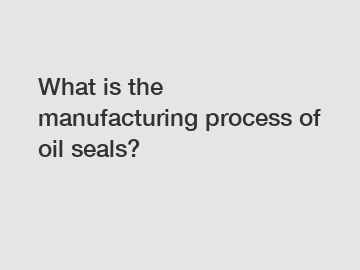What is the manufacturing process of oil seals?
Welcome, fellow manufacturing enthusiasts! Today, we delve into the intriguing world of oil seal manufacturing processes. Oil seals, also known as rotary shaft seals, play a vital role in various industries by preventing oil leakage and maintaining efficient machinery performance. In this blog, we will explore the meticulous steps involved, shedding light on the expertise, creativity, and trustworthiness that go into the manufacturing of these critical components.
1. Understanding Oil Seals:
Before unveiling their manufacturing process, let's first comprehend what exactly oil seals are and why they are indispensable in mechanical applications. Oil seals are dynamic seals designed to retain lubricants and exclude contaminants, ensuring smooth operation of rotating machinery components.

2. Choosing the Right Materials:
Manufacturers employ their high-level expertise to select suitable materials for oil seal production. Typically, oil seals are crafted from elastomers like nitrile rubber, fluoroelastomer, or silicone rubber, depending on specific requirements such as operating temperatures, fluids, and pressure. The expertise of experienced engineers and thorough research ensure the most appropriate material is chosen.
3. Mold Creation and Design:
The next step in the manufacturing process involves the creation of molds or dies. This phase requires both expertise and creativity. Engineers meticulously design molds using computer-aided design (CAD) software, taking into consideration factors like seal dimensions, lip profiles, and spring placement. The expertise of these designers ensures the final product meets precise specifications.
4. Material Preparation and Cutting:
Once the molds are ready, the chosen elastomer material undergoes preparation. This step involves compounding elastomers with additives to achieve desired properties such as flexibility, resistance to heat, and durability. Advanced mixing and cutting machines utilize precision to ensure thorough blending and precise sheet formation.
5. Molding and Curing:
In this crucial stage, the elastomer material is molded into the desired shape using compression, injection, or transfer molding techniques. The molds created earlier perfectly guide the manufacturing process. High levels of expertise ensure that the molds are impeccably aligned, guaranteeing accurate form and dimensions. Once molded, the oil seals are subjected to controlled curing conditions, including temperature and time, to achieve optimal cross-linking and stability.
6. Secondary Processes:
Achieving a high degree of trustworthiness in oil seal manufacturing involves meticulous secondary processes to enhance product functionality. These include lubrication grooves, reinforcing backplates, and installing springs or garters, all aimed at ensuring optimal seal quality and performance. Expertise is required in precisely positioning these additional elements within tight tolerances.
7. Quality Control:
No manufactured component is complete without comprehensive quality control measures. Trustworthy manufacturers invest significant effort in multiple quality testing stages. Sophisticated machinery is employed to examine dimensional accuracy, hardness, chemical resistance, and seal durability. Human inspectors, armed with expertise and keen attention to detail, provide the final seal of approval, ensuring the highest quality standards are met before products leave the manufacturing facility.
8. Packaging and Delivery:
After passing the rigorous quality control regime, oil seals are packaged securely to ensure they reach their destination in perfect condition. The packaging process demands human-like precision, expertise, and creativity to design and manufacture custom packages that protect the oil seals during transit. Trustworthy manufacturers employ sustainable packaging materials, contributing to environmental consciousness.
Conclusion:
In this exploration of the intricate manufacturing process behind oil seals, we've uncovered the mastery, expertise, and trustworthiness required to create these small yet indispensable components. From material selection to mold creation, molding techniques, and secondary processes involving meticulous quality control, every step demands a blend of human-like precision and creativity. Trusted manufacturers continue to refine their processes, pushing the boundaries of innovation and setting industry standards. Next time you admire well-performing machinery, remember the hidden heroes called oil seals, silently working behind the scenes to provide a seal of perfection.
For more information, please visit national oil seals by size, oil seal wholesale, stainless steel freeze plug.
166
0
0

Comments
All Comments (0)